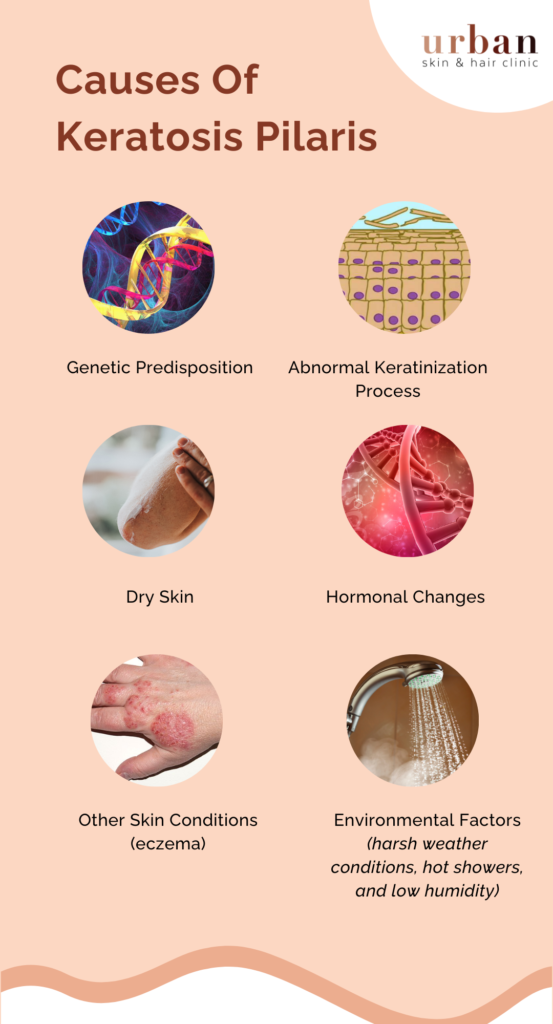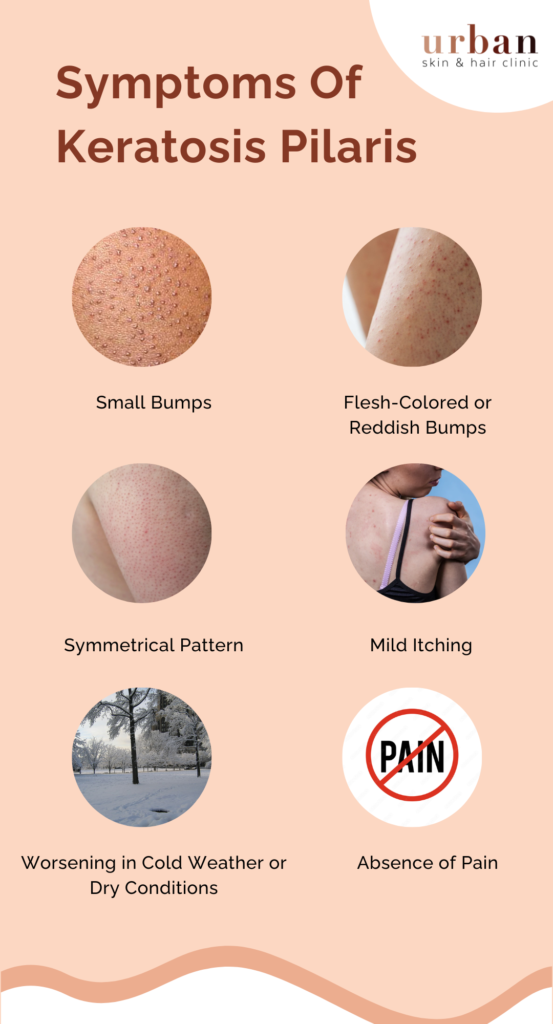
What is keratosis pilaris?
Keratosis pilaris is a common skin condition characterized by small, rough, and raised bumps that often appear on the outer surface of the upper arms, thighs, buttocks, and sometimes the face. These bumps are caused by the buildup of keratin, a protein that forms a protective layer on the skin. Keratosis pilaris is usually asymptomatic but can be cosmetically bothersome.
Seeking professional evaluation at Urban Skin & Hair Clinic can help manage and improve the appearance of keratosis pilaris.
What are The Causes of keratosis pilaris
The excess keratin builds up around hair follicles, leading to the characteristic small, rough, and raised bumps associated with the condition.
While the exact cause of keratosis pilaris is not fully understood, several factors contribute to its development. Here are some potential causes:
- Genetic Predisposition: Keratosis pilaris often runs in families and is believed to have a genetic component. If one or both parents have the condition, their children are more likely to develop it as well. Certain genetic variations may influence the production and regulation of keratin in the skin, leading to the characteristic bumps.
- Abnormal Keratinization Process: In individuals with keratosis pilaris, the process of keratinization, where old skin cells are shed and replaced with new ones, may be altered. This leads to the buildup of excess keratin around hair follicles, resulting in the bumpy appearance.
- Dry Skin: Dry skin is associated with keratosis pilaris, and the condition tends to worsen during colder months or in dry climates. When the skin lacks moisture, the dead skin cells do not shed as efficiently, contributing to the blockage of hair follicles.
- Hormonal Changes: Hormonal changes, such as those that occur during puberty, pregnancy, or hormonal imbalances, may influence the development of keratosis pilaris. Fluctuations in hormone levels can affect the skin’s keratin production and turnover rate.
- Other Skin Conditions: Keratosis pilaris can sometimes coexist with other skin conditions, such as eczema (atopic dermatitis). In these cases, the underlying skin condition may exacerbate or contribute to the development of keratosis pilaris.
- Environmental Factors: Exposure to certain environmental factors, such as harsh weather conditions, hot showers, and low humidity, can lead to dry skin, potentially worsening keratosis pilaris.


Signs & Symptoms of keratosis pilaris
- Small Bumps: The primary characteristic of keratosis pilaris is the presence of numerous small bumps on the skin. These bumps may feel rough or slightly bumpy to the touch.
- Flesh-Colored or Reddish Bumps: The bumps are usually flesh-colored, but they may also appear slightly red or pink due to mild inflammation around the hair follicles.
- Symmetrical Pattern: Keratosis pilaris often appears in a symmetrical pattern, meaning that the bumps are typically distributed in the same areas on both sides of the body, such as on both upper arms or thighs.
- Mild Itching (in some cases): While keratosis pilaris is generally asymptomatic, some individuals may experience mild itching or irritation in the affected areas.
- Worsening in Cold Weather or Dry Conditions: The condition may worsen during colder months or in dry climates when the skin is prone to dryness. Dry skin can exacerbate the appearance of the bumps.
- Absence of Pain or Discharge: Unlike some other skin conditions, such as acne or infections, keratosis pilaris does not cause pain, inflammation, or discharge from the bumps.
Treatment for keratosis pilaris
While there is no known cure for keratosis pilaris, several treatment approaches can help manage and improve the appearance of the condition. The goal of treatment is to reduce the roughness and redness of the bumps and improve the overall texture of the skin.
It’s essential to consult with a dermatologist or medical professional at Urban Skin & Hair Clinic to determine the most appropriate treatment plan based on the individual’s specific condition. Here are the common treatment options for keratosis pilaris:
Keeping the skin well-moisturized is a crucial aspect of managing keratosis pilaris. Regular application of moisturizers helps to soften the skin and reduce dryness, making the bumps less noticeable. Look for moisturizers that contain ingredients like urea, lactic acid, or salicylic acid, as these can help gently exfoliate the skin and improve its texture.
Gentle exfoliation can help remove dead skin cells and smooth the surface of the skin. However, it’s essential to avoid harsh scrubbing or abrasive exfoliants, as they can further irritate the skin. Use a soft loofah or exfoliating cloth to gently massage the affected areas during bathing.
Over-the-counter or prescription creams containing alpha hydroxy acids (AHAs) or retinoids may be recommended to help exfoliate the skin and improve keratosis pilaris. These ingredients can help unclog hair follicles and reduce the appearance of bumps.
In some cases, topical corticosteroids may be prescribed to reduce inflammation and redness associated with keratosis pilaris. However, long-term use of steroids should be avoided due to potential side effects.
Laser treatments, such as intense pulsed light (IPL) or vascular lasers, may be considered for reducing the redness and improving the texture of the skin affected by keratosis pilaris.
It’s essential to discuss the available treatment options with a dermatologist or medical professional to develop a personalized and effective treatment plan. While keratosis pilaris is a harmless condition, addressing its appearance can significantly enhance skin texture and self-confidence. Remember that individual responses to treatment may vary, and it may take some trial and error to find the most effective approach for each person’s unique situation.


